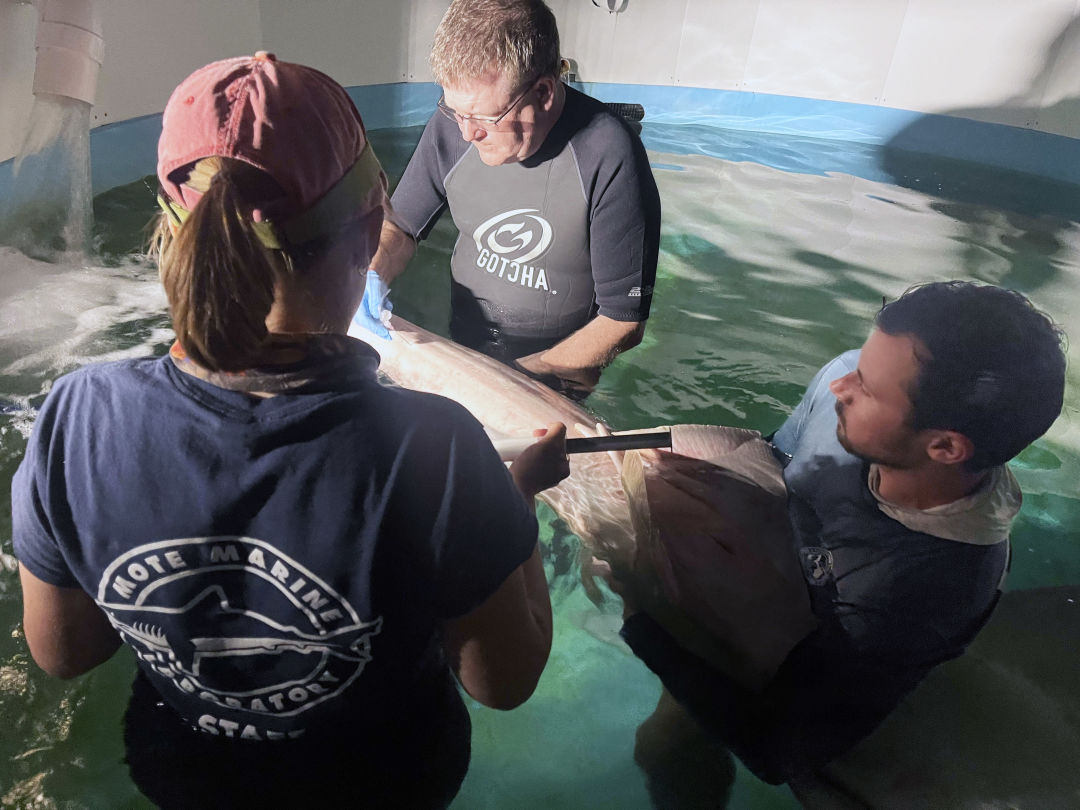Mote, FWC Help Rehabilitate Distressed Smalltooth Sawfish

Image: Courtesy Photo
On Friday, April 5, Mote Marine Laboratory and the Florida Fish and Wildlife Conservation Commission (FWC) responded to a distressed smalltooth sawfish, or carpenter shark, after receiving a call about the animal "spinning"—or swimming in circles—in Cudjoe Bay in the Florida Keys.
Wait, what's this about spinning fish?
Over the past few months, sightings of “spinning” fish across multiple species have been reported in the Keys. There have also been reports of fish deaths— including 38 smalltooth sawfish to date—as well as reports of small-scale fish kills in the area. Scientists do not yet know what is causing the erratic behavior, but NOAA Fisheries has initiated an emergency response effort with FWC, Mote and other partners to rescue, rehabilitate, and release smalltooth sawfish impacted by this event. Mote played an instrumental role more than 2o years ago in providing some of the foundational research that led, in part, to the listing of smalltooth sawfish as the first marine fish placed on the Endangered Species List and designation of Critical Habitat. Investigations into the abnormal behavior and mortalities by FWC are ongoing.
How did Mote and its partners help the sawfish?
During last week's effort, a joint FWC-Mote team of scientists and veterinary staff completed a quick field assessment that included taking samples, measurements, and tagging. The afflicted sawfish was loaded onto a vessel and provided respiratory assistance during the short boat ride to a temporary holding tank at a Mote facility in the Lower Keys, where it received round-the-clock observation by qualified personnel.
That interim holding tank gave the FWC-Mote team a temporary area where they were able to stabilize the sawfish. While it was successfully rescued and received crucial stabilizing care, it remained in critical condition. After several days of treatment and monitoring, the team decided that the animal appeared capable of withstanding the several-hour drive to another Mote quarantine facility designed to provide more extensive rehabilitation treatment for sawfish.
On Thursday, April 11, biologists carefully loaded the sawfish into a transport trailer operated by Ripley’s Aquariums, whose conservation team monitored the sawfish and its water quality conditions throughout the duration of the transport to Mote’s facility.

Image: Courtesy Photo
Now what's going on?
Now receiving treatment at Mote’s more extensive quarantine facility, the sawfish will continue to be monitored 24 hours a day in hopes of fully rehabilitating its health before releasing it.
“This is an unprecedented partnership initiative that is at the core of our mission: using the best available science and technology to rescue, restore and conserve our precious marine species, habitats and ecosystems,” says Dr. Michael P. Crosby, Mote's president and CEO.

Image: Courtesy Photo
How can the public help sick sawfish?
- Report all sawfish observations (healthy, sick, injured, or dead) to (844) 4-SAWFISH (844-472-9347) or [email protected]
- Report abnormal fish behavior and fish kills to the Florida Fish and Wildlife Conservation Commission’s Fish Kill Hotline at (800) 636-0511 or myFWC.com/reportfishkill



